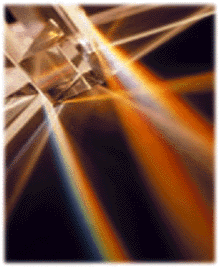

The focus of this paper will be on an emerging technology in
the world of computers and digital information transmission
known as Photonics. Photonics or lightwave transmission is simply
the transmission of a portion of the light spectrum called the
infrared region over fiber optic cable. Actually the "lightwave"
is invisible to the human eye. The ability, of photons rather
than electrons to transmit information is now closer to reality.
Possibile applications include of course military (the mother of
all invention), photonic computers and an all-optic network communications
system. Although this technology is not brand new
recent developments in this field have photonics poised to become
to the twenty first century what electricity was to the
twentieth century.

Currently, desktop computers use electrons to pass information,
but as more circuits are included on new chip, they become
more difficult to cool. Photon particles are faster and cooler
than electrons. Until recently the problem was that no one has
been able to bend useful frequencies of light around tight corners
(as electrons do through a million turns on a computer chip
the size of a postage stamp) without incurring large losses in
information. Previously used techniques leaked light the more
tightly it was turned. Also, wave communication is least
affected by attenuation (thinning or weakening) using the infrared
(IR) region.

The design of devices being developed to achieve the "bend"
or redirection of light vary but each approach is useful depending
on the application. Generally, light doesn't like being
controlled. Unlike electrons that can be easily routed, making
all electronics possible, photons are difficult to direct. Past
photonics devices used to bend light at a 90-degree angle were
bulky and inefficient. Although light traveling through optical
fibers has revolutionized telecommunications, you still need
electronics at each end in the tiny circuits that process the
signals. Precise control in needed to make lightwaves twist and
turn in optical circuits and eventually optical computers.

One device recently developed by Pierre Villeneuve and John
Joannopoulos along with collaborators at Sandia National Laboratories
in New Mexico is an optical material called a photonic
crystal. The two MIT physicists created linear defects in the
crystal after determining that photonic crystals are opaque to
certain wavelengths of light. Since photons can travel along the
defects, they reasoned that it would be possible to route the
light along the created path. After further collaboration with
nearly one hundred percent efficiency, Joannopoulos proved his
theory that photovic crystals could be used to guide light
around corners. It is now only a matter of shrinking the crystal
down to bend light at about 1.5 micrometers and control the
light in three dimensions. According to Shawn Lin, the Sandia
electric engineer who is building the crystal,"it's very difficult
but it can be done. We're on the verge of a breakthrough,
and the devices that then could be realized are up to your imagination."
The structure, of the lattice crystal in the
regularity and spacing of its parts, is like a mirror in that it
does permit light of a particular frequency, caught within the
cavity of the structure, to escape. As a result, light must
follow along any twists or turns designed into the log cabin or
cage like structure formed by the stacked lattices.

Another photon based approach to achieve optical switching capability is termed, Photonic slot routing. According to this approach, entire slots, each carrying multiple packets (one on each wavelength) are "transparently" routed through the network as single units so that wavelength sensitive data flows can be handled using fast-switching wavelength nonsensitive devices based on proven technologies.
A good deal of attention is being given to the development of optical networks. The motivation behind the efforts is the potential for creating the "all-optical" network. In such a network, data once sent into the network, is not converted back to electronic form until it reaches the destination. The benefits of an all-optical netwouk include: terabits per second bandwidth with low bit error rates, data transparency and free- dom from interference resulting in a secure communication system. Due to the rapid rise in telecommunications traffic, as a result of Internet expansion, the demand for a high-capacity optical systems is approaching urgent proportions. Systems with the capacity to transmit digitized voice,data and video as light impulses over multiple wavelengths, also called channels, on individual strands of optical fiber are needed. This technique of designating a system for sending two or more signals simultaneously over the same circuit or strand is known as multi- plexing.
Among optical multiplexing techniques, wavelength-division multiplexing (WDM) provides a promising solution for an all- optical network. It allows the potential terahertz bandwidth to be multiplexed into parallel channels, each operating at a speed compatible with the speed of today's electronics. Many Internet service providers have started to deploy Wave Division Multiplexing therebyt transmittingmultiple wavelengths -or colors - of light on the same fiber strand,with each wavelength carrying a distinct stream of information. Because much of to- day's technology involves thd transmission of very closely spaced wavelength/colors, the tedhnique is called Dense Wave Division Multiplexing (DWDM). These dense wave systems can combine in the range of 80 - 100 wavelengths of light on one fiber. This will enabling service providers to offer hundreds of times more bandwidth without incurring the cost of laying more fiber. It is easy to see now why photonics has become the medium of choice for most service providers. Current optical networks cannot be scaled by simply adding nodes to existing systems due to the limited number of wavelengths. A solution which has the attention of a large number of industry researchers is to switch packets among adjacent subnetworks on a wavelength basis. Such a solution is not possible due to the unavailability of fast-switching wavelength sensitive devices. With the recent trend in network technologies to increase the speeds of the trunks, attention to switching element speeds has fallen behind. Research is required to determine the feasibility of achieving totally photonic switches in the network switching nodes.Until just recently the photonic end of the Internet has been more of a junction or switching station where light impulses,or photons, transporting information over fiber cable switch to metal wire electronic impulses.
Now, there appears to be a shift in the potential of
photonics toward the direction of an all-optical network, with
as much of an emphasis as possible on transparency with regard
to modulation programs, bit transfer rates, and transport protocol,
network traffic will not need to be converted into electrons
along the way (as is currently done), thereby making
the transmission more efficient.

"It appears highly likely that networks will at some point in the future be totally photonically switched, having the impact on networking comparable to the effect of integrated circuits on processors and memories." http://solarisguide.com/rfc/rfc1077.shtml
HISTORY:
In the early 1970's, experiments conducted at Bell Labs proved that lightwave communication over fiber optic cable was feasible. The first commercial use of fiber optics was tested in a 3.7 mile long telephone system designed by Bell Labs in downtown Chicago, Ill.
Three years later, construction in the United States began on a 611 mile long lightwave line called the Northeast Corridor, extending from Boston to Washington D.C.
Since that time, digital lightwave systems began to rapidly replace analog microwave transmission facilities in long distance networks throughout the world, and later began to replace the digital copper wire T1 facilities in the local networks. Today, a number of systems are being evaluated to provide lightwave connectivity i n the subscriber line, that portion of the telephone network that uses copper wire, called twisted pair, to connect homes and small businesses to local switching offices.
Although photonic lightwave transmission seems to still be in its early stages of development compared to its potential, it has a history of over one hundred years.
By the late 1870's with the financial security of his telephone invention to support all future endeavors, Alexander Graham Bell's primary scientific pursuet became searching for a way to communicate electrically without wires.
Beginning with ways to refine the Samuel F.B. Morse closed circuit wireless telegraph using water as a conductor, Bell abandoned the project when experiments with salt water weren't so successful. He then developed the idea of transmitting and receiving sound with a beam of light and for two years devoted all his energy to the goal, along with an optical instruments makerby the name of Charles Sumner Tainter. Perfection of the photophone was acheived in early 1880. The transmitter, a mirror reflected a beam of light through a set of lenses, which focused the light onto a vibrating diaphragm, which reflected it toward the receiver. At the receiver, a curved cone shaped reflector collected the light and focused it onto a selenium cell wired to a telephone circuit.
The point of the photophone history is to point out that although Alexander Graham Bell perfected the device the technology suffered from an inability to be deflected around corners and the device was susceptible to inclement weather. What makes fiber optic cables so useful is they can be bent in any direction or shape even tied in a knot (not recommended). to avoid failures, installation specifications limit the cables radius bend. But todays fiber optic cable is pretty flexible. But what keep the light inside the cable since light has the ability to travel out into all directions? The glass portion of an optical cablel consists of two regions, the core that runs through the center of the strand, and the cladding that surrounds the core. Although light rays want to go in a straight line, when they are aimed, or coupled, by a light source into a fiber, some of the photons will enter the core at widely divergent angles. The cladding, which is said to have a different refractive index than the core, acts as a mirror. It causes the infra-red light rays to reflect back into the core during their transmission through the system. Since the light rays are traveling through the core at different angles, they will arrive at different times at the end of their journey. The result is and opptical signal that is dispersed, that is, spread out over time. The wider the pulse spread, the less bits per second that can be transmitted on the system. Bend the fiber to the right,the light goes to the right. Bend the fiber to the left, the light goes to the left. Fiber optics solves two of the problems that earlier lightwave systems couldn't. Cladding deflects the light around corners and cables are not affected by weather.
How the light wave system is composed can be broken down into four basic parts:
1-LIGHT SOURCE in the transmitter can be a light emitting diode (LED) or a laser (light amplificstion simulated emission of radiation). This source is modulated or turned on or off in a digital system to represent the binary digits (1 and 0) it receives from an electrical transmission system.
2-FIBER OPTIC CABLE, either a single strand or multiple strands bundled together, each strand about the thickness of a human hair is wrapped in a protective covering.
3-REGENERATOR, as a photonic signal travels through a fiber optic strand, is attenuates, beginning to lose its shape. If not regenerated periodically, the signal won't be recognizable at the receiving end. Regenarators can either be optical- electrical-optical devices, usually used in land systems or all-optical systems found in undersea lightwave systems.
4-PHOTODETECTOR, in the receiver, takes the optical signal from the fiber and converts it into an electrical signal for transmission through the non-optical portions of a network.
Another optical related technology with enormous potential is holographic storage which is already possible but not available commercially. Holographic storage provides dramatic advances in both data storage density and transfer rates required by the latest Internet applications and data warehousing.
References:
http://www.htc.honeywell.com/projects/proh.html
http://www.solarisguide.com/rfc/rfc1007.shtml
http://www.bell-labs.com/news/html
http://www.bell-labs.com/org/physicalsciences/projects/hdhds
http://www.lucent-optical.com/vision/
http://www.beyondcomputers.org
http://www.htc.honeywell.com:80/photonics/index.html
http://web.mit.edu/mpc/www/publications/newsletter/ newsletter.html
http://www.sandia.gov/media/photonic.htm
http://www.nytimes.com/circuits
http://web.mit.edu/mpc/www/Microphotonics/